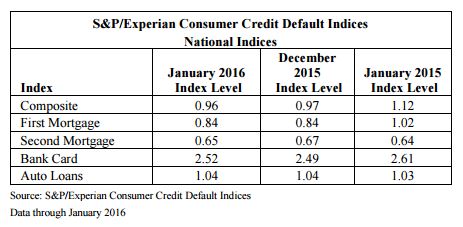 First mortgage default rates started the new year exactly where they left the old one, according to the latest S&P/Experian Consumer Credit Default Indices (a.k.a. SPICE Indices), released Tuesday.
First mortgage default rates started the new year exactly where they left the old one, according to the latest S&P/Experian Consumer Credit Default Indices (a.k.a. SPICE Indices), released Tuesday.
According to the report, first mortgage and auto loan default rates were unchanged for January, with default rates of 0.84 percent and 1.04 percent, respectively. Three of the five major cities, Los Angeles, Chicago, and Dallas, did see their default rates increase in January over December, however. Los Angeles reported a default rate of 0.72 percent, which is up seven points from December; Chicago increased two points to 1.02 percent; and Dallas rose one point to a default rate of 1.11 percent.
Of the remaining major cities on the SPICE Indices, New York recorded a default rate of 1.04 percent in January for the second consecutive month, while Miami showed a huge decrease of 27 points in January, reporting a default rate of 1.17 percent for the month.
Tuesday’s report answers recent speculation about whether national default rates would remain as steady as they were in Q4 of 2015. Last year was up-and-down for default rates, though Q4 finished with three consecutive months of slight increases. David Blitzer, Managing Director & Chairman of the Index Committee at S&P Dow Jones Indices, cautioned at year’s end that a quarter does not a trend make and said that there were “no seasonal patterns or other concerns that stand out” about Q4’s numbers.
Blitzer was similarly levelheaded (and optimistic) about the newest numbers, and reminded that indices, despite the turbulence, are still low and that things generally are running smoothly.
“The series established a new low point in November and remains quite low compared to its recent history,” he said. “Moreover, the small decline in first mortgage defaults offset any damage in bank cards.”
 On a regional basis, Blitzer said, the five cities noted in the release “bounced around, but none appeared to be warning of future difficulties. The economy is taking on something of a split personality.”
On a regional basis, Blitzer said, the five cities noted in the release “bounced around, but none appeared to be warning of future difficulties. The economy is taking on something of a split personality.”
Blitzer cited falling prices and volatility in the market so far this year, when the stock market is down about one percent, interest rates remain low in spite of the Fed raising rates in December, and concerns about corporate earnings and credit are widespread.
But on the upside, he said, “home prices continue to climb, new homebuilding is rebounding, and auto sales have been quite strong. The unemployment rate ticked down to 4.9 percent in January.”
Overall, he said, consumers do not appear to be overly worried about the stock market and consumer spending patterns haven’t collapsed.
“Given further modest job growth and continued low inflation,” he said, “there is no basis for near-term worries over consumer spending.”

 DSNews The homepage of the servicing industry
DSNews The homepage of the servicing industry









